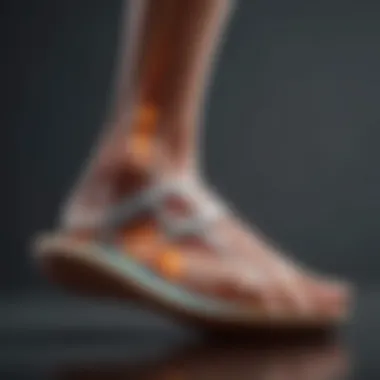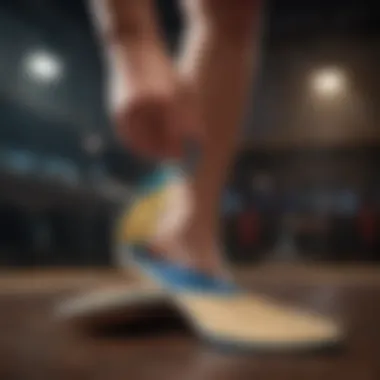Understanding Shoe Insoles for Shin Splints Relief


Intro
Shin splints, or medial tibial stress syndrome, often arise from overexertion, improper footwear, or incorrect running techniques. This condition leads to pain along the inner edge of the shinbone, significantly hindering one’s physical performance. Individuals seeking relief and prevention often overlook the critical role that shoe insoles can play in managing shin splints. Insoles can offer customized support, absorb shock, and promote proper alignment, thus reducing the risk of injury.
In this article, we will explore the mechanics of shin splints, the function of insoles, and how to choose the right type based on personal circumstances and activity levels. Understanding these factors is essential not just for athletes, but for anyone who engages in any form of physical activity.
Key Benefits
Physical Health Benefits
Using shoe insoles contributes significantly to physical health, especially for those susceptible to shin splints. Insoles serve multiple functions:
- Support: They provide necessary arch support which can alleviate stress on the lower leg.
- Shock Absorption: Insoles can absorb impact forces during running or walking, minimizing stress on the shinbone.
- Alignment: They promote better foot alignment, which can directly affect the knees and hips, ensuring balanced movement.
These benefits are crucial not just for individuals with shin splints, but for anyone engaging in regular physical activity. Correcting foot mechanics through suitable insoles can lead to a drastic reduction in occurrence of related injuries.
Mental Well-being Enhancements
Physical discomfort can often lead to mental stress as well. The persistent pain of shin splints can deter individuals from engaging in enjoyable activities. By utilizing instep supports, the distraction of pain is minimized, which allows for greater focus on fitness objectives and overall well-being.
Moreover, achieving fitness goals provides a sense of accomplishment, boosting overall mental health. Knowing that one can manage or prevent shin splints through appropriate insole use creates a positive feedback loop in terms of motivation and self-efficacy.
Proper foot support can significantly enhance performance and reduce the risk of shin splints, contributing to both physical and mental well-being.
Practical Tips
Choosing the Right Insoles
When selecting insoles to combat shin splints, consider the following elements:
- Arch Height: Understand your arch type (low, medium, high) to choose insoles that support your foot correctly.
- Material: Gel insoles offer good cushioning, while foam insoles may provide better support and durability.
- Activity Level: For runners, investing in sporty insoles designed for impact absorption is advisable.
Incorporating Insoles into Regular Use
To effectively integrate insoles into your routine:
- Gradual Incorporation: Start wearing them for short periods to allow your feet to adjust.
- Use in All Footwear: Ensure insoles are present in all shoes you use for activity.
- Monitor Feedback: Pay attention to how your body responds to the insoles and make adjustments if necessary.
These practical tips can help in optimizing the benefits of insoles, allowing individuals to enjoy a pain-free experience while engaging in their desired physical activities.
Preface to Shin Splints
Shin splints, medically known as medial tibial stress syndrome, represent a significant concern for many individuals, particularly athletes and active enthusiasts. Recognizing the implications of shin splints is essential for understanding how shoe insoles can serve as both a preventive and treatment measure. This article aims to unravel the complexities of shin splints, their causes, and the pivotal role insoles play in mitigating symptoms and enhancing overall performance.
Defining Shin Splints
Shin splints are characterized by pain along the shin bone, known as the tibia. This discomfort often arises during physical activities, especially those involving running or jumping. The pain may be sharp or dull and can vary in intensity from mild to debilitating. Identifying shin splints in their early stages can help prevent more severe conditions, such as stress fractures. Therefore, understanding this condition is crucial for anyone engaged in regular physical activity.
Common Causes
The development of shin splints is typically attributed to several factors, including:
- Overuse: Repetitive stress from high-impact activities can lead to inflammation of the muscles, tendons, and bone tissue around the shin.
- Improper Footwear: Wearing shoes that do not offer adequate support or cushioning can exacerbate the risk of developing shin splints. Shoes that are worn out or not suitable for an individual's foot type can contribute significantly to this problem.
- Training Errors: Sudden increases in the intensity or volume of exercise, or inadequate rest, can overload the lower leg, resulting in shin splint pain.
- Biomechanical Issues: Poor foot alignment, flat feet, or high arches can put excess strain on the muscles in the lower leg, making one more susceptible to shin splints.
Understanding these common causes is the first step in addressing shin splints effectively. Addressing footwear, training techniques, and the overall biomechanics of movement is crucial for prevention and management.
The Anatomy of the Lower Leg
Understanding the anatomy of the lower leg is fundamental in discussing shin splints and the role of shoe insoles. The lower leg contains several key structures that contribute to movement and stability during physical activity. Gaining insight into these elements helps elucidate the causes of shin splints and how the correction offered by insoles can alleviate discomfort. Moreover, recognizing how different muscles and alignment of bones affect performance is essential for athletes and fitness enthusiasts.
Muscles Involved
The lower leg consists of multiple muscle groups, each playing a distinct role in movement and support.
- Tibialis Anterior: This muscle runs along the front of the shin and is responsible for dorsiflexion, which allows the foot to lift towards the leg. Weakness or tightness in the tibialis anterior can lead to pain during running or walking, contributing to shin splints.
- Gastrocnemius and Soleus: Located at the back of the lower leg, these muscles work together to perform plantarflexion, allowing the foot to point down. If these muscles are overly tight, they can place additional stress on the tibia, exacerbating shin splint symptoms.
- Peroneal Muscles: These are located on the outside of the lower leg and are essential for stabilizing the ankle. Weakness in these muscles can lead to improper foot placement, increasing the risk of injuries.
Awareness of these muscles aids in understanding how specific exercises can strengthen them, reducing the chances of developing shin splints, and highlighting how insoles provide additional support for these muscle groups.
Impact on Performance


The anatomy of the lower leg directly influences athletic performance. Each muscle plays a critical role in how an athlete moves and responds during physical activity. Considerations include the following:
- Power and Agility: Strength and flexibility in the lower leg muscles enhance power output during sprints and jumping activities.
- Balance and Coordination: Proper function of the lower leg muscles is crucial for maintaining balance, which is vital in sports like basketball or soccer.
- Injury Prevention: By promoting better alignment and support through insoles, athletes can maintain optimal muscle function and minimize the risk of injuries related to the lower leg and feet.
"Biomechanics of the lower leg significantly dictate athletic performance and recovery. Understanding this is key to preventing injuries like shin splints."
In summary, the anatomy of the lower leg encompasses vital muscles that directly influence movement and performance. A comprehensive understanding of how these elements interact can help in developing personalized approaches for injury prevention, rehabilitation, and enhancing overall athletic capabilities.
Role of Footwear in Shin Splints
Footwear plays a crucial role in both the prevention and management of shin splints. This connection arises from how shoes interact with the biomechanics of running and other activities. An appropriate shoe can provide necessary support, cushioning, and alignment for the feet and legs, mitigating the risk of developing shin splints. A failure to choose the right footwear can exacerbate existing problems and potentially lead to more severe injuries.
When considering footwear, it is vital to recognize the specific design elements that contribute to shin splint symptoms. The way a shoe is constructed influences how forces are absorbed and distributed throughout the lower extremities.
Footwear Design and Support
Footwear design involves multiple components such as the sole, upper construction, and heel height. These elements contribute to overall support and stability.
- Cushioning: Shoes with adequate cushioning help to absorb impact during high-impact activities. This cushioning reduces the stress placed on the shins, helping to prevent injury.
- Arch Support: Proper arch support accommodates the natural curvature of the foot. Shoes designed for specific arch types can enhance comfort and alignment while running or walking.
- Heel Control: The shoe’s heel design can influence foot position during movement. A well-designed heel can keep the foot aligned, reducing the risk of strain on the shin.
Pairing shoes with appropriate insoles can enhance their effectiveness. Insoles can further increase arch support and absorb impact, linking design and functionality in a way that supports athletic activities.
Limitations of Standard Shoes
Standard shoes, while often convenient, come with notable limitations.
- Generic Fit: Many standard shoes are manufactured with a one-size-fits-all approach. This can lead to inadequate support for those with unique foot shapes, increasing the risk of injury.
- Limited Customization: Standard options may lack specific features that can address individual needs. For example, someone with high arches may find that a generic shoe does not provide the required elevation and support.
- Material Composition: Shoes made with lower quality materials often fail to provide adequate durability and support, leading to a breakdown quicker than higher-quality options.
It is essential to assess footwear critically. Evaluating the design, support, and limitations of standard shoes can guide individuals towards making more informed purchasing decisions, alleviating symptoms of shin splints and promoting healthier physical activity.
Understanding Shoe Insoles
Shoe insoles are critical components in managing shin splints effectively. These inserts are designed to provide added support and can significantly influence comfort and injury prevention. Understanding their role can lead to informed choices that enhance performance and reduce discomfort.
Custom or generic insoles can affect alignment, impact distribution, and overall foot function. Their advantages include better shock absorption, improved arch support, and enhanced stability during physical activities. Given their varied designs and functionalities, selecting the right insole is paramount for anyone dealing with shin splints.
What are Shoe Insoles?
Shoe insoles, also known as orthotic inserts, are removable layers placed inside shoes to enhance comfort and support. They serve multiple purposes, such as cushioning the foot, providing arch support, and aiding in the alignment of the entire lower body. Effective insoles can also absorb shock during physical activities, which is vital for athletes who are prone to shin splints.
These insoles come in various shapes, materials, and thicknesses, tailored to accommodate different foot types and specific user needs. It’s essential to understand that not all insoles are created equal; their effectiveness can vary significantly based on one's unique biomechanics and the type of shoes they are paired with.
Types of Insoles Available
When it comes to addressing shin splints or enhancing foot health, knowing the available types of insoles is vital. Each type of insole provides specific benefits, which can be particularly useful for individuals engaged in athletics or prolonged standing.
Orthotic Insoles
Orthotic insoles are crafted to provide customized support for misalignments and specific foot conditions. They often feature rigid shells that promote proper foot positioning. A key characteristic of orthotic insoles is their ability to redistribute pressure across the foot’s surface. This aspect effectively alleviates pain associated with shin splints and lowers the risk of recurrence.
However, orthotic insoles may require some breaking in as they can feel stiff at first. Their higher cost can also be a consideration, but the long-term benefits often outweigh initial investment.
Gel Insoles
Gel insoles offer significant cushioning, which aids in shock absorption. Their primary characteristic is the use of gel material that conforms to the foot’s shape, enhancing comfort. This makes them a popular choice for individuals involved in high-impact sports.
While gel insoles provide excellent cushioning, they may lack adequate arch support for those with specific foot issues. They can compress over time, losing some of their shock-absorbing capabilities, which might necessitate more frequent replacements.
Foam Insoles
Foam insoles, made from memory or latex foam, are designed to contour to the foot’s shape, offering a high level of comfort. Their primary benefit lies in their cushioning ability, making them a good option for everyday use to relieve shin splints.
The downside of foam insoles is that they may not provide the rigid support needed for serious athletes. Over time, foam can compress, potentially leading to reduced efficacy when it comes to shock absorption and support.
Custom Molded Insoles
Custom molded insoles are specially designed to fit the unique contours of an individual's foot. Typically created from a mold of the foot, these insoles offer unparalleled support and alignment. Their key characteristic is the precise fit, which caters to specific foot conditions and biomechanics.
Although these insoles may be more expensive due to their bespoke nature, they can significantly enhance comfort and lower the risk of injury. However, the time required to make the molds and create the insoles can be a drawback for individuals seeking immediate relief.


Understanding the types of insoles available is crucial for anyone dealing with shin splints. Each type has its own advantages and disadvantages, and making an informed choice can lead to better outcomes in managing symptoms.
How Insoles Can Alleviate Shin Splint Symptoms
Insoles play a notable role in managing the symptoms of shin splints. These symptoms often arise due to various factors such as improper footwear, overtraining, or biomechanical issues. Selecting proper insoles can effectively address the underlying causes of discomfort. Let’s explore how insoles can assist in alleviating symptomss and improving performance.
Shock Absorption
One of the primary functions of insoles is shock absorption. When individuals engage in high-impact activities like running or jumping, the feet experience substantial force. Insoles designed specifically for shock absorption can mitigate this force. Materials like gel or foam are commonly used in such insoles.
These materials compress under pressure but rebound quickly, distributing the impact more evenly across the foot. This helps prevent excessive strain on the shins, reducing the risk of developing pain. Research indicates that increased shock absorption correlates with reduced injury rates among athletes. Therefore, investing in quality insoles can lead to better long-term outcomes for those prone to shin splints.
Arch Support
Proper arch support is crucial for maintaining foot alignment. Many individuals have flat feet or high arches that can lead to imbalances during movement. Insoles with arch support can help stabilize the foot. This stability contributes to better distribution of weight across the foot, promoting a more natural gait.
Insufficient arch support can exacerbate the symptoms of shin splints. Supportive insoles minimize this risk by enhancing comfort and stability. Studies show that insoles providing appropriate arch support lead to significant improvement in foot mechanics. Thus, evaluating one’s foot type is an essential step in selecting the right insoles for arch support.
Improved Alignment
In addition to shock absorption and arch support, insoles can enhance overall alignment during movement. Poor alignment can lead to unnecessary stress on the lower leg. Insoles with features that promote alignment can help to correct this issue.
For example, insoles that support the midfoot can align the tibia and reduce the excess rotational forces often associated with shin splints. An aligned foot reduces the tension in the calf and shin muscles during physical activities. Proper alignment is critical, especially for those involved in repetitive movements. As a result, using insoles for alignment can effectively alleviate the discomfort caused by shin splints.
Research emphasizes the importance of utilizing insoles to address specific foot mechanics to prevent further injury.
In summary, insoles can provide multiple benefits for individuals experiencing shin splints through shock absorption, arch support, and improved alignment. By choosing the right insoles, individuals can mitigate pain and enhance performance in their activities.
Selecting the Right Insoles
The choice of insoles can significantly affect the management of shin splints. Selecting the right insoles involves understanding your individual foot type, what features of the insoles align with your specific needs, and how these elements can contribute to your overall comfort and support during activities. Making an informed decision is essential. It can help in alleviating symptoms and preventing future occurrences.
Assessing Your Foot Type
Foot type plays a crucial role in determining which insoles will be most beneficial. A person's foot type typically falls into three categories: neutral, flat, and high-arched. Neutral feet have a balanced arch, providing good stability. Flat feet lack a defined arch and often require additional support to correct alignment issues. High-arched feet experience a disproportionate amount of weight on the heel and ball of the foot, which can lead to strain.
To assess your foot type, you can perform a wet footprint test: wet your feet and step onto a dry surface, observing the print. This will help identify your arch type based on how much of your foot makes contact with the surface. Knowing your foot type will guide you in selecting insoles designed specifically for your structure, thus minimizing discomfort and maximizing support.
Insole Characteristics to Consider
Thickness and Cushioning
Thickness and cushioning are critical aspects to consider when choosing insoles for shin splints. The right level of cushioning can absorb excess impact from activities. Thicker insoles often provide enhanced shock absorption, crucial for reducing strain on the shins during high-impact exercises. However, too thick insoles can lead to instability. The ideal insoles should balance cushioning with support to maintain proper foot alignment while reducing injury risk.
Material Composition
The material of the insoles greatly affects performance and comfort. Popular types include foam, gel, and cork, each providing different levels of support and flexibility. Foam insoles are lightweight and often molded to the foot shape, offering good shock absorption. Gel insoles provide extra cushioning and reduce pressure points. However, they may wear down faster than other types. Understanding the material composition helps in selecting insoles that complement individual activity levels and foot shapes efficiently.
Stability Features
Stability features of insoles can aid in maintaining proper foot alignment. Support elements like arch support and heel cups stabilize the foot, preventing excess movement that may contribute to shin splints. Stability-enhancing insoles can be especially beneficial for individuals with flat feet or those prone to overpronation. However, excessive rigidity in these insoles might limit natural foot movement. Therefore, it is crucial to strike a balance between stability and flexibility for optimal results.
"Choosing the right insoles tailored to your foot type and activity level can significantly improve comfort and reduce the likelihood of shin splints."
In summary, selecting the right insoles is not merely about comfort. It involves understanding your foot structure, the characteristics of insoles, and how these aspects contribute to performance and injury prevention. Assessing both foot type and insole features will lead to informed and effective choices.
Incorporating Insoles into Your Footwear
Integrating insoles into your footwear is pivotal for anyone dealing with shin splints. Properly incorporating these support devices can directly influence comfort and performance. It is important to understand how insoles fit correctly within your shoes and their role in alleviating discomfort while promoting overall foot health. Getting the insertion right can enhance the positive effects of insoles, ensuring they serve their intended purpose.
Insoles should align seamlessly with the inside of your footwear, providing adequate support without causing crowding or discomfort. This creates the right environment for your feet during physical activities. Moreover, when correctly positioned, insoles help in distributing weight more consistently across the foot, reducing pressure points that may lead to injury.
Proper Insertion Techniques
Inserting insoles into your shoes may seem straightforward, but certain techniques can optimize their effectiveness. Follow these steps for proper insertion:
- Remove Existing Insoles: Start by taking out the shoe's original insoles. This allows your new insoles to fit snugly.
- Check the Size: Ensure your new insoles match the shoe's size. If they are too large, you may need to trim them. Most insoles feature a trim line to guide you.
- Place Insoles Correctly: Insert the insoles into the shoe, making sure they sit flat against the bottom. Any bubbles or wrinkles can cause discomfort and reduce performance.
- Test Fit: After placing the insoles, put on your shoes and walk around. Ensure they feel comfortable and do not cause any tight spots.
Using the proper techniques for insertion can make a significant difference in how effectively the insoles mitigate the symptoms of shin splints.


Adjustment Period
When integrating new insoles, it is common to experience an adjustment period. This phase is crucial as your body acclimatizes to the new support. Initially, you may notice slight discomfort as the insoles reshape your standing and walking patterns. This is normal, and it typically subsides with time.
During the adjustment period, consider these strategies:
- Gradual Use: Start by wearing the insoles for short durations. Gradually increase the time until your body adapts to the new support.
- Focused Activities: Initially, engage in activities that require less impact to test comfort levels. For example, short walks can be more beneficial than long runs during this phase.
- Listen to Your body: Pay attention to any discomfort or pain. If it persists beyond the typical adjustment timeframe, reassess your selection of insoles or consult a health professional.
"Insoles are a significant component of footwear for shin splint management, but their success heavily relies on correct installation and a thoughtful adaptation process."
Complementary Strategies for Managing Shin Splints
Successfully managing shin splints requires a multifaceted approach. While shoe insoles are beneficial, they should be part of a broader strategy that includes various complementary methods. Focusing on strengthening exercises, stretching routines, and appropriate rest and recovery can significantly enhance overall treatment effectiveness. These strategies not only help in alleviating current discomforts but also work as preventive measures against future occurrences.
Strengthening Exercises
Strengthening exercises target the muscles around the lower leg, contributing to greater stability and support. By developing these muscles, the risk of shin splints can be notably reduced. Key exercises include calf raises, toe taps, and ankle circles.
- Calf Raises: This exercise involves standing straight and raising your heels off the ground, balancing on your toes. It’s effective in strengthening the calf muscles, which play a crucial role in absorbing shock during running and jumping.
- Toe Taps: While seated, you can tap your toes on the ground repeatedly. This light exercise strengthens not just the toes, but also the muscles in the lower leg.
- Ankle Circles: Rotate your ankles in circular motions, both clockwise and counterclockwise. This mobility exercise enhances flexibility and counteracts stiffness.
Regular execution of these exercises can help in building a stronger foundation for movements, ultimately supporting the shin area more effectively.
Stretching Routines
Integrating stretching into your routine is essential. Adequate stretching helps maintain flexibility, which can minimize tension in the muscles surrounding the shins. Implement hamstring stretches, calf stretches, and quadriceps stretches into your regimen.
- Hamstring Stretches: Bend forward while seated to stretch the hamstrings; this can alleviate tightness that contributes to shin pain.
- Calf Stretches: Stand facing a wall and lean into it while keeping the back leg straight to stretch the calf muscles effectively.
- Quadriceps Stretches: Stand tall and pull your ankle to your glutes to stretch the quads. Tight quadriceps can lead to imbalances that aggravate shin splints.
Incorporating these stretches can improve muscle elasticity and reduce the overall strain on the shin area during physical activities.
Rest and Recovery
Rest is an often underestimated component of managing shin splints. It is vital to give the body ample time to heal and recover between activities. Overtraining can exacerbate shin splints and lead to other injuries.
- Scheduled Rest: Designate specific rest days and integrate them into your weekly routine. This allows your muscles time to recover from stress.
- Active Recovery: Engage in low-impact activities, such as swimming or cycling, on rest days. These alternatives help keep your body moving without placing additional stress on the shins.
- Sleep: Quality sleep is crucial. It is during sleep that the body does much of its repairing work. Aim for 7-9 hours of restful sleep each night to support overall recovery.
By focusing on these complementary strategies, you can more effectively manage shin splints. This augmented approach ensures that the use of shoe insoles is balanced with physical conditioning, flexibility, and adequate recovery.
Potential Drawbacks of Insoles
Insoles play a significant role in enhancing comfort and preventing injuries such as shin splints. However, it’s essential to recognize that insoles are not a panacea. Understanding the potential drawbacks can help individuals make informed decisions regarding their use.
Misalignment Issues
One major concern with shoe insoles is the risk of misalignment. If insoles are not chosen or fitted correctly, they may alter the natural alignment of the feet and legs. This misalignment can lead to a cascade of problems, including additional stress on other joints, such as the knees and hips. It’s crucial to ensure that the insoles support the foot's arch and heel properly. Poor fit or inappropriate support can exacerbate existing foot conditions or result in new pain.
Regular assessment of one's foot position and insole function is necessary. Custom insoles, while often seen as the best option, may also present challenges. They should accommodate specific foot anatomies and dynamics under load; otherwise, they risk causing discomfort and further misalignments.
Over-Reliance on Insoles
Another aspect to consider is the risk of over-reliance on insoles. Some individuals may become dependent on insoles for comfort and support, neglecting other crucial elements of foot health. While insoles can provide immediate relief, they might mask underlying issues related to foot strength and flexibility.
Relying solely on insoles may discourage individuals from engaging in exercises that strengthen foot and calf muscles, which are vital for maintaining proper biomechanics. This dependency can lead to reduced natural muscle engagement, causing weakness over time. It is essential to view insoles as a tool within a broader approach to health and wellness rather than a permanent solution.
Finding a balance between utilizing insoles and strengthening the foot is key to long-term health.
In summary, while insoles can significantly alleviate symptoms of shin splints, awareness of these potential drawbacks is essential. Individuals should prioritize finding the right balance between using insoles and addressing overall foot health through strength training and proper footwear.
End and Recommendations
In addressing shin splints, understanding how to integrate shoe insoles into your routine is crucial. The conclusion of this article synthesizes the comprehensive information on insoles, emphasizing their role in both prevention and recovery. It is vital to acknowledge that selecting appropriate insoles can significantly reduce discomfort associated with shin splints. The right insoles provide necessary support, allowing for better alignment and weight distribution when engaging in physical activities, thus mitigating strain on the lower legs.
Review of Key Insights
Reviewing the core aspects highlighted throughout this article reveals several important points:
- Shoe insoles offer various types that can be tailored to individual foot mechanics, such as orthotic, gel, foam, and custom molded options.
- Enhancing shock absorption, improving arch support, and maintaining proper alignment are critical factors that insoles address to relieve shin splint symptoms.
- Incorporating insoles into footwear requires proper insertion techniques and can necessitate an adjustment period for optimal comfort and effectiveness.
- While insoles can be beneficial, it is essential to recognize potential drawbacks, including misalignment and over-reliance on support devices.
This highlights the importance of balancing the use of insoles with other strategies such as strengthening exercises, stretching routines, rest, recovery, and proper footwear.
Making Informed Choices
When it comes to selecting the right insoles, making informed choices is paramount. Consider the following strategies:
- Assess your foot type. Understanding whether your feet are flat, neutral, or high-arched can guide you in choosing insoles that provide ideal support.
- Evaluate insole characteristics. Look for insoles with adequate thickness and cushioning, combined with materials that offer durability and responsiveness. Stability features can enhance performance during high-impact activities.
- Consult with professionals. Health professionals, such as podiatrists or physical therapists, can provide guidance tailored to your specific needs, helping you navigate the wide array of options available. Making these decisions with care can lead to better management of shin splints and improved overall physical health.
In sum, effectively managing shin splints encompasses a comprehensive approach that includes utilizing suitable shoe insoles. With the correct insights and strategies, individuals can enhance their physical performance and reduce the risk of shin splint symptoms.















